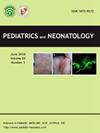Effectiveness of corticosteroids and epinephrine use in neonates for the first extubation attempt: A retrospective study
IF 2.3
4区 医学
Q2 PEDIATRICS
引用次数: 0
Abstract
Background
This study aimed to analyze the use of corticosteroids and epinephrine in neonates for the first extubation attempt and compared clinical characteristics of infants with successful and failed extubation events.
Methods
This was a retrospective cohort study conducted at a single level III neonatal intensive care unit in Taiwan. The study included 215 infants born between 2020 and 2021 who had been intubated for more than 48 h before their first extubation attempt. We compared perinatal and peri-extubation characteristics and outcomes between the two groups. Successful extubation was defined as freedom from invasive ventilatory support 72 h after extubation. The relationship between corticosteroids, local epinephrine, and successful extubation was determined using multivariate logistic regression analysis.
Results
In the univariate analysis, the failed extubation group received a significantly higher proportion of intravenous dexamethasone (p = 0.006) than the successful extubation group. Furthermore, the failed extubation group had a longer duration of nebulized epinephrine (p = 0.034) and more episodes of local application of epinephrine to the superior larynx (p = 0.003) than the successful extubation group. Multivariate analysis revealed that the absence of lung atelectasis, tachycardia 72 h after extubation, and lower post-extubation PCO2 were the key factors associated with successful extubation.
Conclusions
There were trends toward systemic dexamethasone, local application of epinephrine to the superior larynx, and longer duration of nebulized epinephrine in the reintubation group. However, corticosteroid or local epinephrine use was not significantly associated with successful extubation. Lung atelectasis, elevated levels of carbon dioxide, and tachycardia were identified as risk factors for extubation failure.
新生儿首次尝试拔管时使用皮质类固醇和肾上腺素的效果:回顾性研究
本文章由计算机程序翻译,如有差异,请以英文原文为准。
求助全文
约1分钟内获得全文
求助全文
来源期刊

Pediatrics and Neonatology
PEDIATRICS-
CiteScore
3.10
自引率
0.00%
发文量
170
审稿时长
48 days
期刊介绍:
Pediatrics and Neonatology is the official peer-reviewed publication of the Taiwan Pediatric Association and The Society of Neonatology ROC, and is indexed in EMBASE and SCOPUS. Articles on clinical and laboratory research in pediatrics and related fields are eligible for consideration.
 求助内容:
求助内容: 应助结果提醒方式:
应助结果提醒方式:


